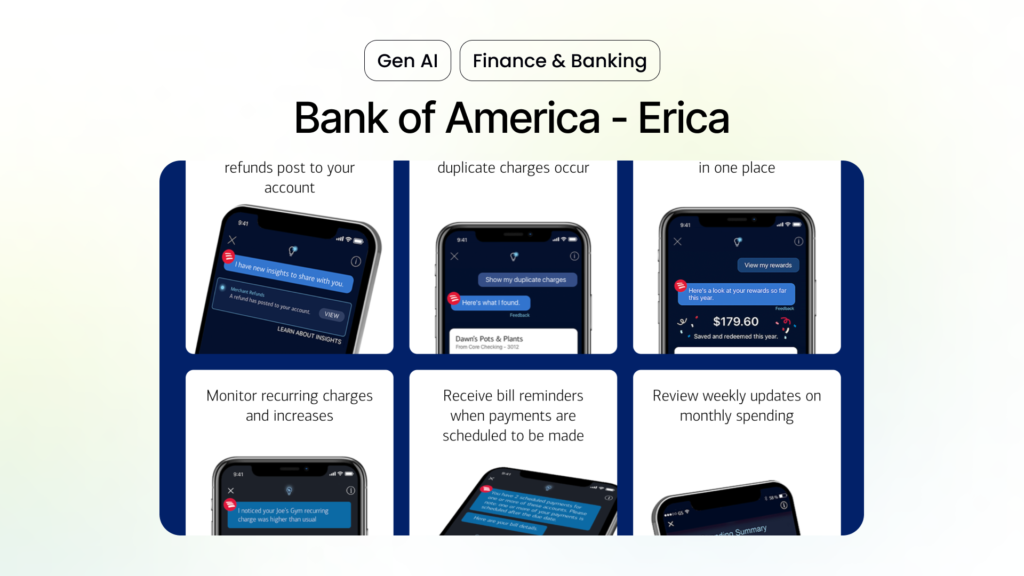Conversational AI in Business is transforming the interaction between companies with their customers. This advanced AI technology enables computers and machines to engage in natural, human-like conversations.
Imagine visiting a website like GoDaddy to purchase a domain and encountering a friendly pop-up assistant offering help. That’s Conversational AI in action.
Unlike traditional chatbots that rely on predefined scripts, Conversational AI uses sophisticated algorithms and Natural Language Processing (NLP) to understand and respond dynamically, making interactions more personalized and efficient.
While traditional chatbots are limited to specific tasks, Conversational AI platforms like Amazon Echo and Apple’s Siri exhibit broader capabilities, thanks to NLP. This allows them to handle a wider range of queries, learning and evolving from each interaction.
So, what makes Conversational AI so revolutionary, and how can it be applied across various business functions? Let’s dive into 10 impactful use cases.
10 Use Cases of Conversational AI in Business
1. Customer Support with Conversational AI
Conversational AI can revolutionize customer support by providing instant, accurate responses to customer inquiries. These AI-driven systems can handle large volumes of queries 24/7, reducing wait times and significantly enhancing customer satisfaction. With the ability to understand and process natural language, conversational AI can offer personalized responses and resolve issues more efficiently than traditional methods.

2. Customer Onboarding and KYC Verification
Automating the customer onboarding process, including Know Your Customer (KYC) verification, can dramatically speed up account creation while ensuring compliance with regulatory requirements. Conversational AI can guide customers through the necessary steps, verify documents, and answer any questions in real time. This not only simplifies the onboarding process but also improves the overall user experience by making it more straightforward and less time-consuming.
3. Conversational AI locates ATM and Branch Facilities
Conversational AI can help customers find the nearest ATMs or branch facilities quickly and efficiently. By simply asking the virtual assistant for the closest location, customers receive precise information based on their current location, including directions and operational hours. This convenience eliminates the need for manual searches and makes accessing banking services more seamless.
4. Accounts Management
Managing accounts has never been easier with the help of conversational AI. These systems can assist customers in checking balances, reviewing transaction histories, and even transferring funds between accounts without needing to navigate complex banking portals. By providing a user-friendly interface, conversational AI enhances the ease of account management and ensures that customers can perform essential banking functions with minimal effort.
5. Payments and Transactions Reminders
AI-driven assistants can send reminders for upcoming payments and transactions, ensuring customers never miss a due date. They can also facilitate bill payments directly through the conversation, making the process seamless and hassle-free. This feature is particularly beneficial for managing recurring bills, subscriptions, and other regular financial commitments, helping customers stay organized and financially responsible.
6. Self-Service Facilities
Empowering customers with self-service options through conversational AI reduces the burden on human agents and improves efficiency. Customers can resolve common issues like resetting passwords, updating personal information, and accessing frequently asked questions independently. This not only enhances the user experience but also allows human agents to focus on more complex and high-priority tasks.
7. Market Insights and Suggestions
Businesses can leverage conversational AI to provide market insights and suggestions based on customer behavior and preferences. By analyzing interaction data, AI systems can identify trends and patterns that help businesses tailor their services and products to meet customer needs more effectively. This data-driven approach can lead to better decision-making and improved customer satisfaction.
8. Personalized Product Recommendations
Conversational AI can analyze customer interactions and purchase history to offer personalized product recommendations. By understanding individual preferences and shopping habits, AI can suggest products that are more likely to meet the customer’s needs and interests. This personalized approach not only enhances the shopping experience but also drives sales and fosters customer loyalty.
9. Risk Management
In the financial sector, conversational AI can play a crucial role in risk management. By continuously analyzing transaction patterns and identifying anomalies, AI can alert customers and institutions to potential fraudulent activities. This proactive approach helps in mitigating risks and protects both the customers and the financial institutions from potential losses.
10. Feedback Collection
Collecting customer feedback is vital for continuous improvement of products and services. Conversational AI can solicit feedback after interactions, analyze sentiments, and provide actionable insights to enhance offerings. By understanding customer experiences and addressing areas of concern, businesses can make informed decisions that lead to better service quality and increased customer satisfaction.
5 Steps to Build a Seamless Conversational AI in Business
1. Map the Customer Journey
To deliver a seamless conversational experience, it’s essential to understand the customer journey. Map out the typical questions customers ask, identify gaps in current customer service, and categorize queries to develop specific remedial methods. This ensures that the AI interactions are aligned with customer convenience and expectations.
2. Select the Right Conversational AI Partner
Choosing a reliable Conversational AI partner is critical. Look for vendors who offer customizable solutions and regular updates. A robust partner like App0 can provide the necessary tools to create and deploy intelligent AI agents tailored to your business needs. Their AI assistants offer human-like interactions, fostering meaningful connections with your customers.
3. Leverage Human Agents When Necessary
While Conversational AI can handle many tasks independently, integrating human agents into the system is crucial. Over 85% of users expect to have the option to speak with live agents. Combining AI with human support ensures that complex issues are handled with the empathy and expertise that only humans can provide.
4. Strengthen Cybersecurity Measures
Security is paramount, especially when dealing with sensitive financial data. Regularly update security protocols to protect customer information from potential threats. Ensure that your Conversational AI solution complies with industry standards to maintain customer trust and confidentiality.
5. Gather Valuable Customer Insights
Implementing Conversational AI is just the beginning. Continuously collect and analyze customer feedback to refine the AI system. Understanding customer preferences and demands enables businesses to make data-driven improvements, enhancing the overall customer experience.
Integrating Conversational AI in Business
Conversational AI is not just a futuristic concept but a present-day reality reshaping business interactions. From customer support to risk management, its applications are vast and invaluable. By understanding and leveraging these use cases, businesses can significantly enhance efficiency, personalization, and customer satisfaction.
Ready to transform your business with Conversational AI? Partner with Innovators Hub Asia today and explore the potential of AI-driven solutions tailored to your needs.







